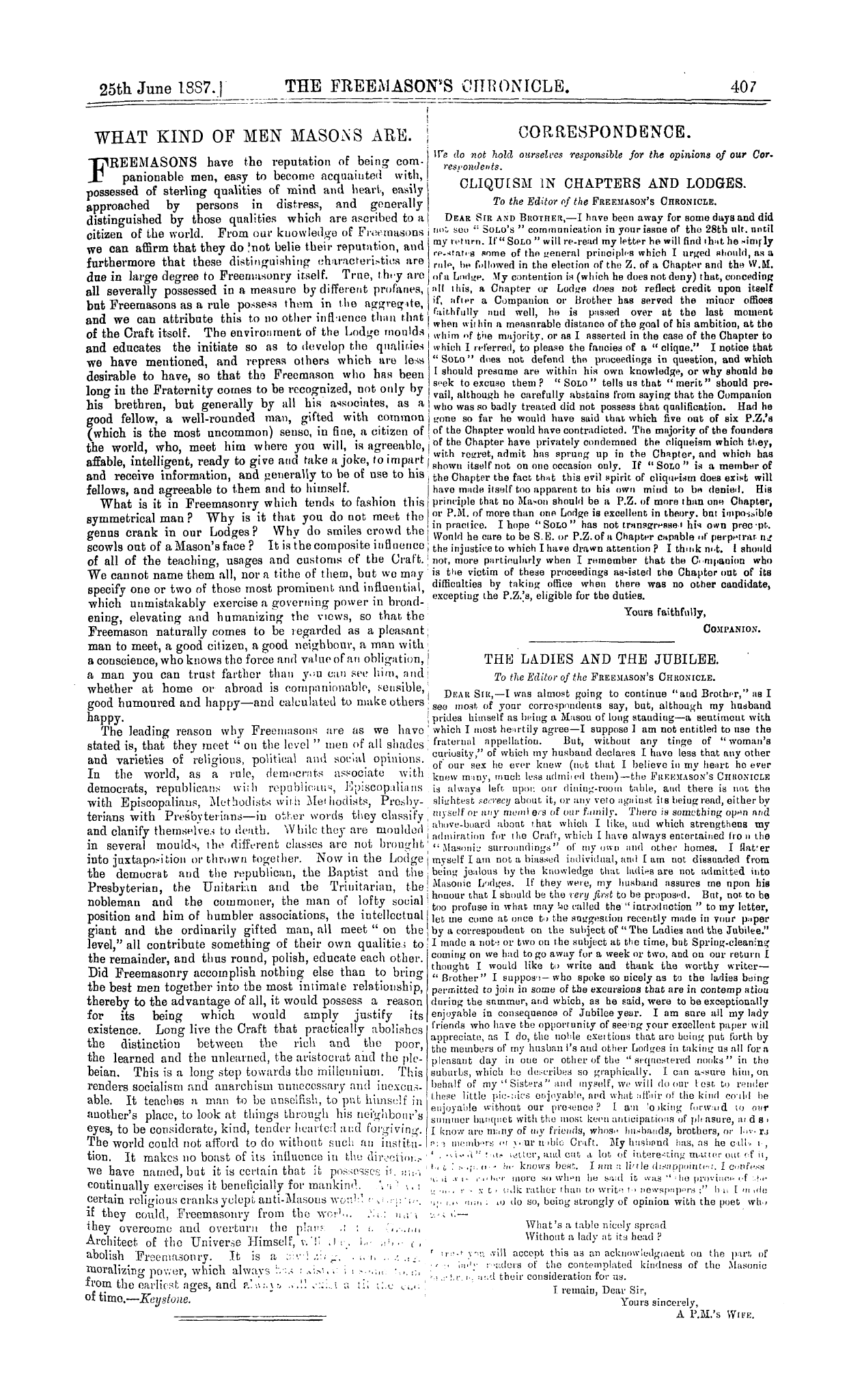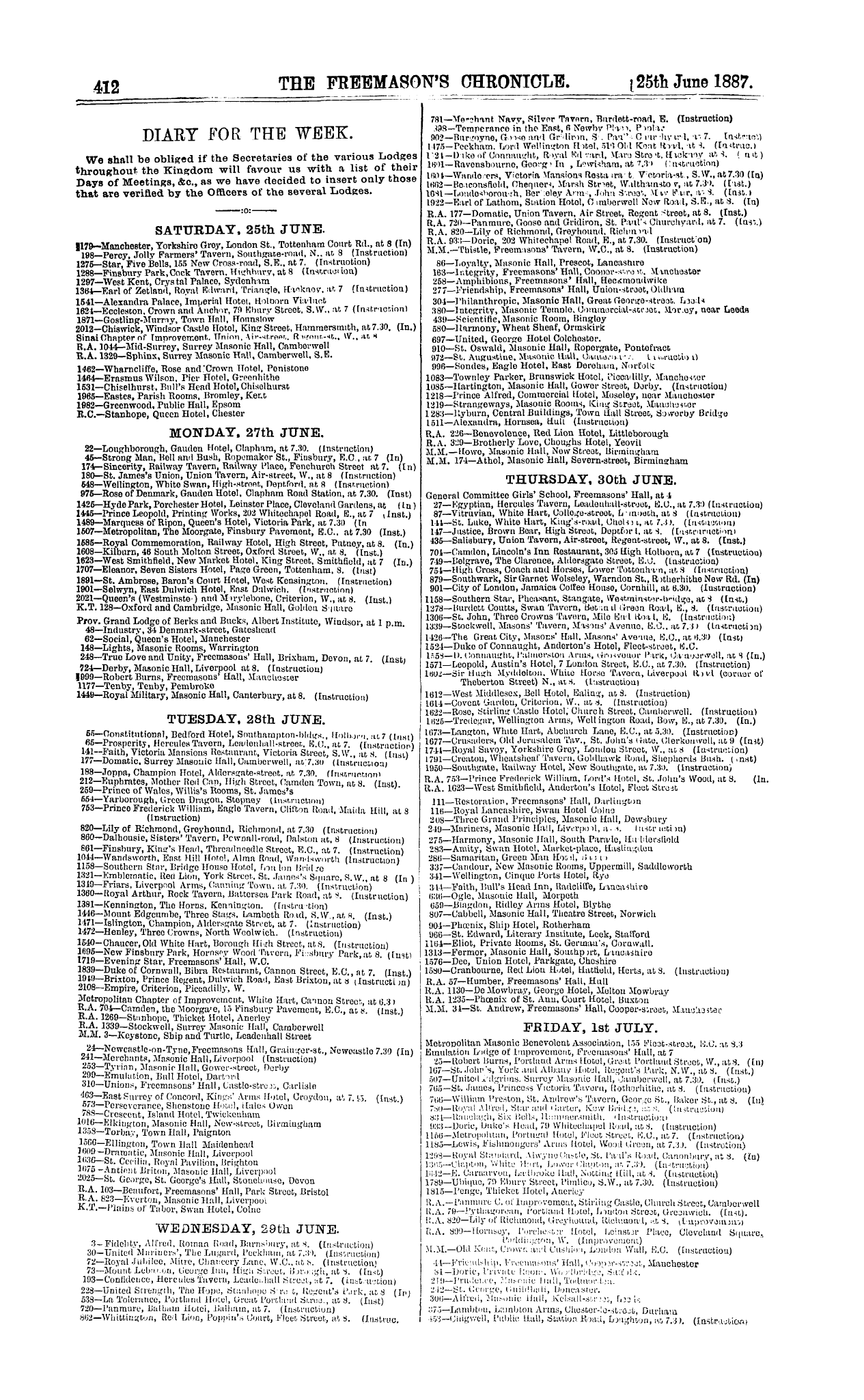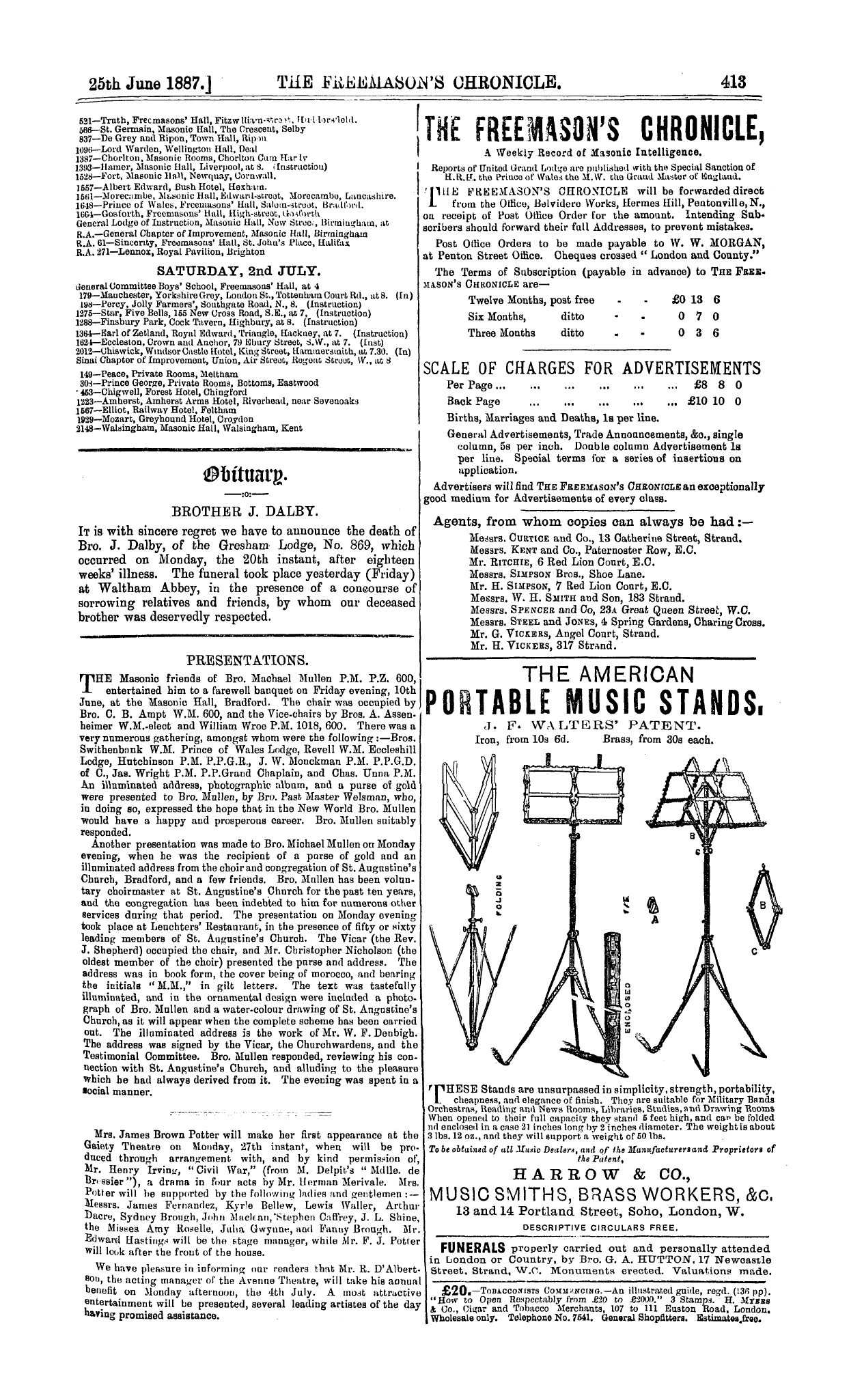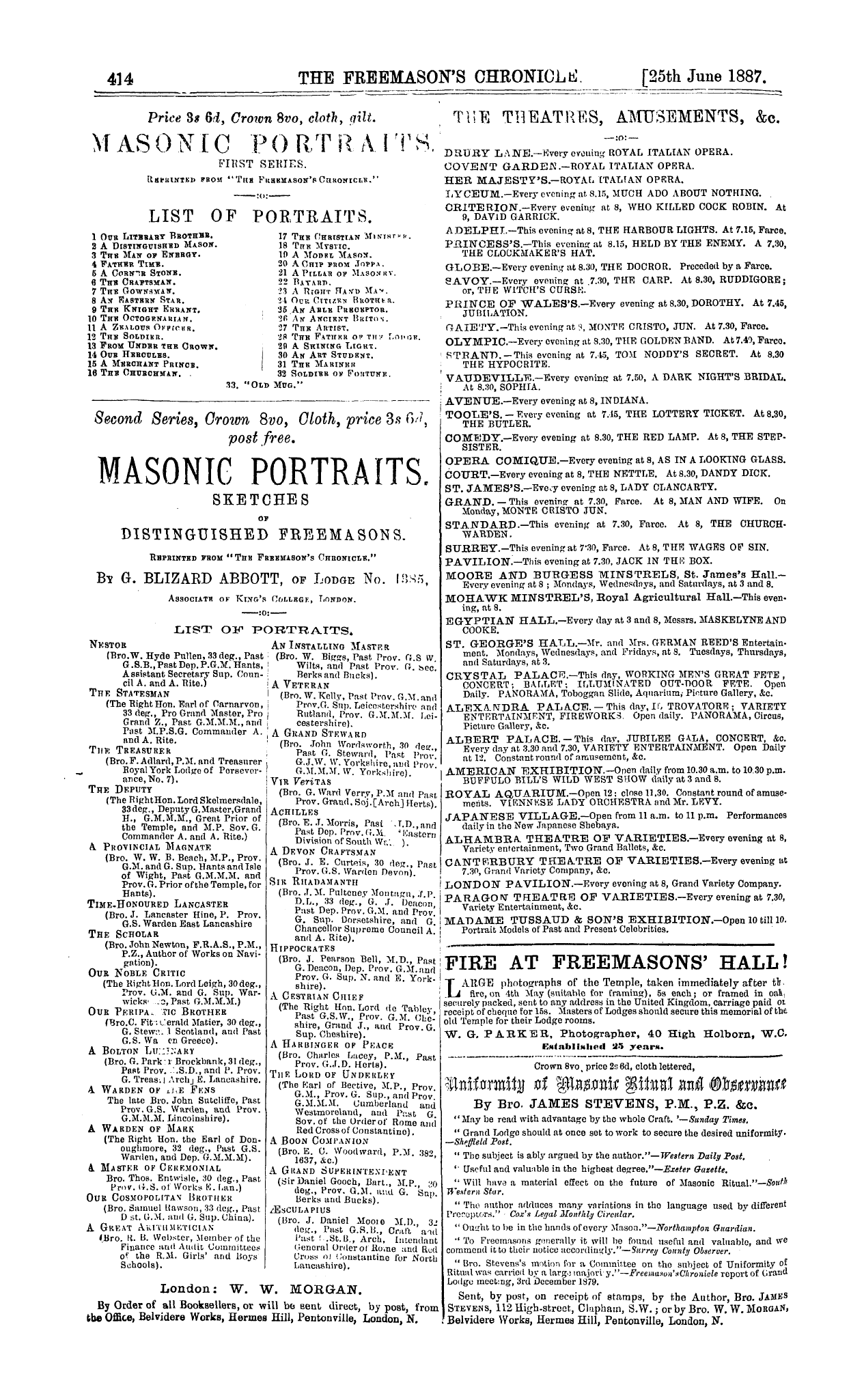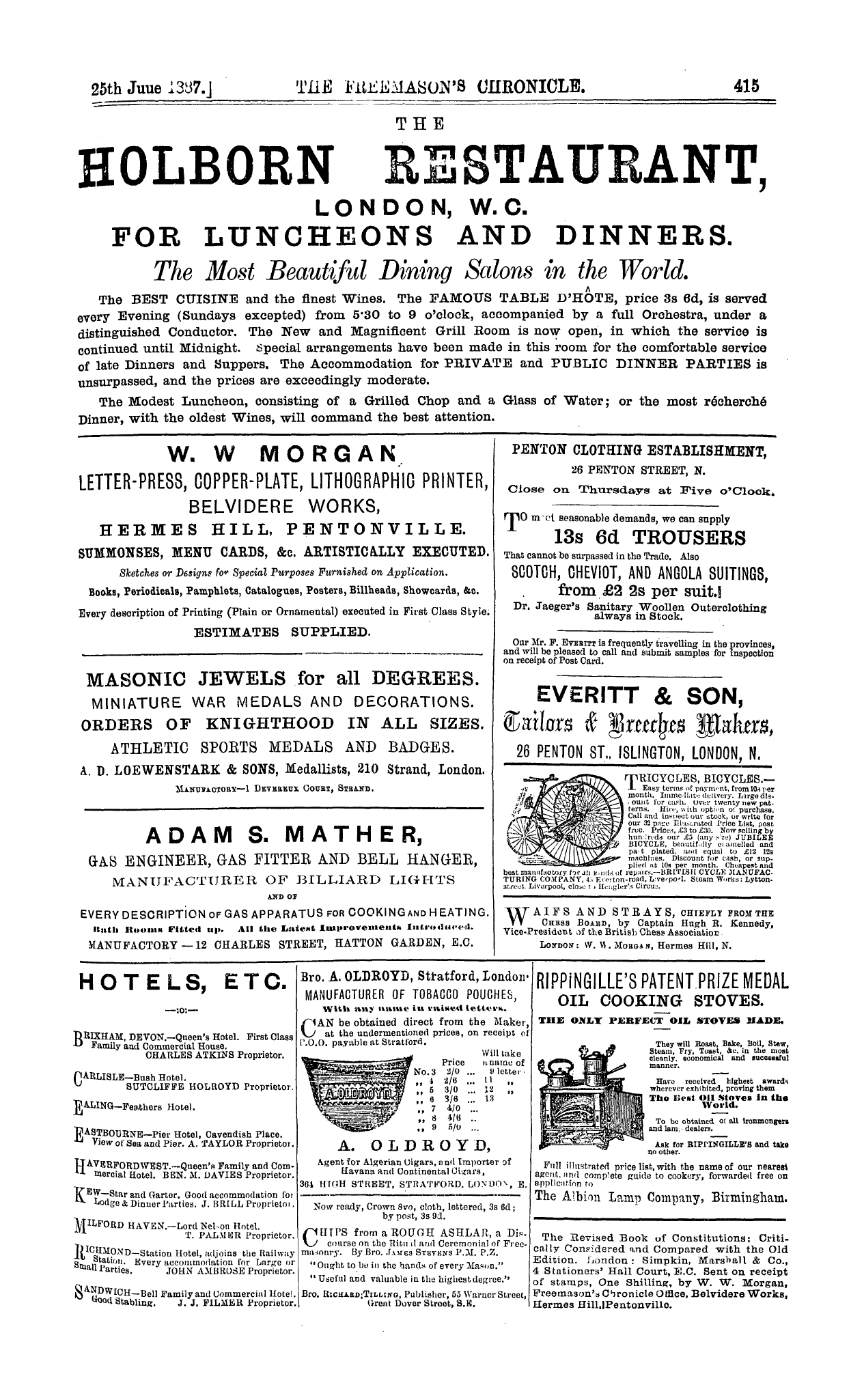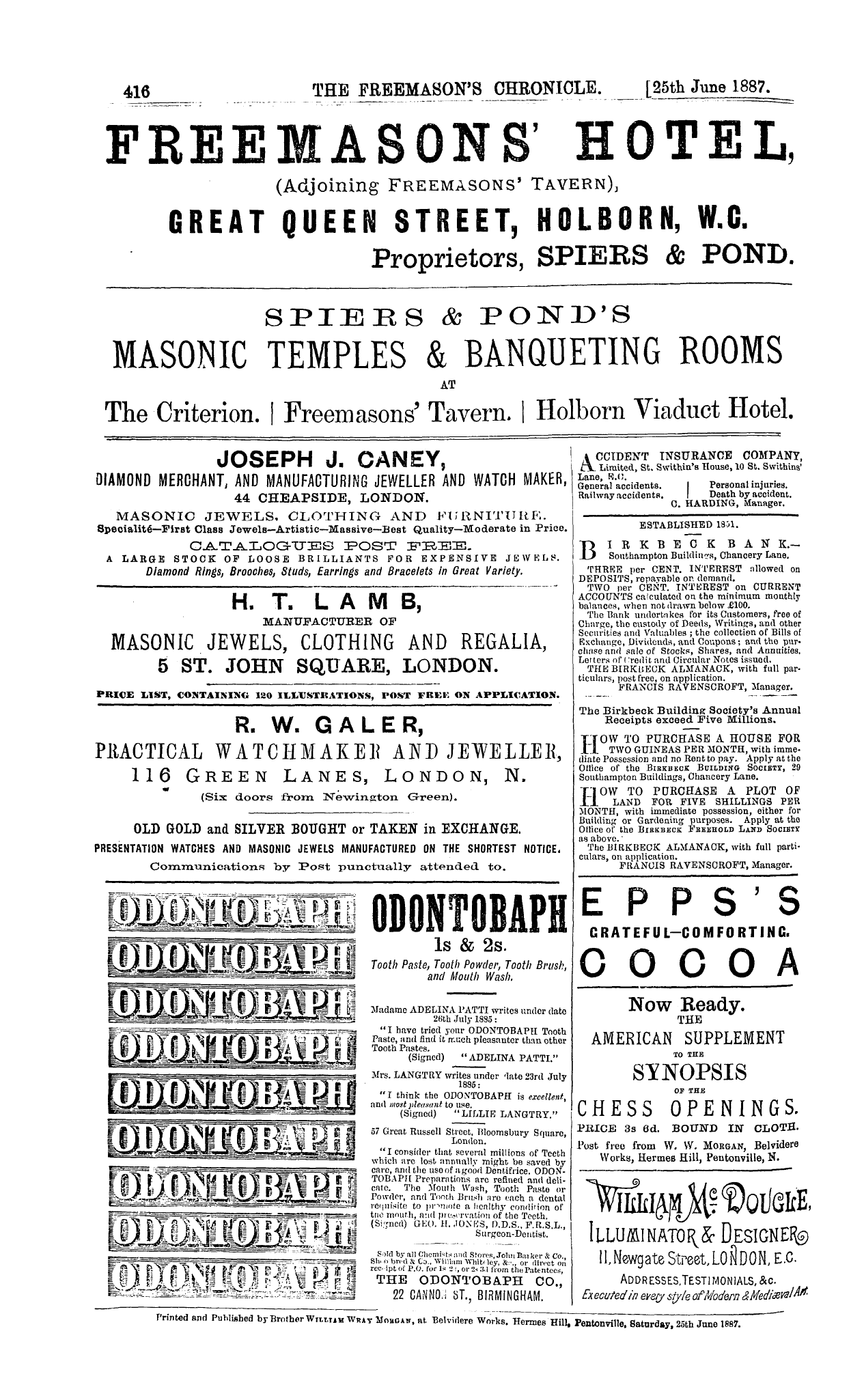-
Articles/Ads
Article AN ORATION. Page 1 of 1 Article AN ORATION. Page 1 of 1
Note: This text has been automatically extracted via Optical Character Recognition (OCR) software.
An Oration.
AN ORATION .
Delivered by Comp . the Eev . G . Benton Wood , M . A ., P . Z 279 , P . P . G . R ., on the occasion of the Consecration of the St . George ' s Chapter , attached to the Albert Edward Lodge , No . 1560 , Leicester , on the 2 nd March 1886 .
I PEEL honoured by your command to address the Provincial Grand Chapter on this occasion—an occasion which has not occurred in the Province for many years . I had intended to preface my remarks with some historical notes on the existing Chapters of the Province ,
bnt , Most Excellent , after listening to your address , such notes would be superfluous . I content myself , therefore , with stating that there is material evidence that Brethren ¦ were exalted in the Royal Arch , in this town , irrespective
of tho Chapter of Fortitude , as long ago as A . D . 1805 . I wear to-day a jewel which has been used time out of mind at the exaltation of Royal Arch Companions . It bears tho name of " Robt . Wylie , No . 91 , A . D . 1805 . " No . 91 was
tbe old Lodge of so-called Atholl Masons referred to in your Address . The Chapter of Fortitude also possesses another jewel , dated 1818 , both of which differ in some respects from those at present authorized .
The total number of subscribing members in the Province is only 160 , of whom 92 are members of the Chapter of Fortitude . Many of these are old Masons , who may be considered to be on the retired list ; whilst many more
seera to regard the Royal Arch as of no more importance than any of the "Side Degrees '' now worked in this country . The nett result is , that the average attendance afc the Convocations of the Chapter of Fortitude , counting
members and visitors of all ranks , is for the past five years just twenty . What the proportion may have been in the smaller Chapters I know not , but there is no reason to suppose it greater .
Why , then , is the Supreme Order of tho Royal Arch in such a languishing condition , when the Mark Degree and other Masonic systems now worked in our midst are continually gaining accessions of strength , and , so far as one is able to judge , prospering exceedingly ?
A chief cause , no doubt , is novelty . To many minds the multifarious clothing , jewels , and paraphernalia of these various Orders have a great attraction , and whereas a principal charm of Masonry is the consciousness of secret
knowledge , which gives a sense of superiority over those who have it not , this feeling is intensified by ( lie multiplicity of Degrees taken ; and the young Mason is tempted to wander off the beaten track in search of abstruse and
complicated instruc ! ion before he br . s acquired the genuine secrets of a M . A I ., and the allurements of office sometimes lead him to seek employment outside his Lod
Another cause is the want of more instructiou durino- a brother ' s novitiate . Are nofc degrees conferred in too quick succession ? Is nofc fche feeling growing that eandidates have a sort of claim and right to the succeediri"
degrees at the earliest possible date allowed b y the Constitutions ? And do uot many of our rising brethren in consequence claim office as a ri ght , whether qualified or not ? If a candidate is led to suppose within three months
of his initiation that , having taken the third degree , he has arrived at the summit of his profession , is he not apt to feel disappointment , and ran wo wonder thafc lie should seek after noveltv and try to quench his rising thirst for
knowledge at every fresh fountain to which lie can y'tin access , rather than rest content under the vine of his own Lodge and drink of his own oistcrn ? A Craftsman may lawfully travel , as his ancient brethren did , from east to
extremest west to seek out new Masters and learn new modes of work ; bufc he should at least know well how to indent on the rough and try the smooth before lie sets out . So long as minute instruction in the three degrees is little
attended to , so long as slovenly signs and tokens are tolerated , tracing boards neglected , aud the work of a Lodge restricted , by common consent , to the ceremonial
conferring of degrees , on the principle of "the more the merrier , " quality iu candidates being held secondary to quantity , the Royal Arch being -ever so much as hinted
at all along , ifc is fco be feared that the Supreme Order will not conquer that place in the estimation of tho brethren
at large with its importance demands . Tiiei-e are even ia Leicester too many Masonic meetings of one kind or another ; and time is devoted to other dri'Tccs
An Oration.
which would perhaps be better spent in striving to attain the " climax of Freemasonry , " for the ritual is extensive and complicated , and can hardly be mastered on the few occasions set apart for the
exercise of it . When oral tradition was the rule , personal instruetion was necessary , and therefore available ; we have now to rely too much on other means of obtaining
the requisite knowledge , the correctness of which is doubtful , and the Companion who does his best in that direction too often fails to satisfy either himself or his predecessors in office .
But , happily , there aro landmarks and limits within which an aspirant cannot widely err . In ritual we are apt to attach too much importance to our own views of verbal accuracy , wdiereas the doctrine of
limits , which runs like a thread throughout the Craft Degrees , appears to me as applicable to ritual as to morals . In the first degree , we have brought to our notice the
two grand parallels between which , so long as a brother confines himself aud marches steadily onward with the eye of faith fixed on thafc star of hope which illumines the immense vista , he cannot err .
The point within the circle conveys tho same idea . The landmarks bound the horizon , and whereas the limit of every circle is a rectangle contained by fche radius and half fche circumference , the Mason standing in the centre
can still discern the two great parallels of the law of God and the rules of the Craft , stretching along on either side towards the distant Royal Arch—like the lines on a railway . For if a material circle be divided into a large
number of equal sectors , and these bo arranged side by side , alternately point to base , it will be seen that they approximate to the rectangle above mentioned ; and here I see the origin of the indented or tesselated border and
the pattern of a Companion ' s badge . And the idea of two grand parallels is dominant in-the Royal Arch itself . Nofc onl y are there two pairs of them within the jewel , bufc the limit of the curve called catenary is two parallel
straight lines ; for the two parts of a flexible cord suspended by its two ends , are ( if very long in proportion to the distance between them ) practically parallel to one another . In the Royal Arch we have impressed on our
minds the strength and durability of a vault or dome constructed on the princip le of the true Catenarian Arch , standing complete in itself without buttress or load of any kind . Such an Arch stands self-supported
onl y when the curve from which it takes its name can be accurately traced between the limits of the outer and inner edge of the voussoirs . This again reminds me of the path of a stedfast Mason amid the
landmarks of his Order , containing his words and very thoughts within the compass of propriety , and going on his humble way rejoicing in the light which God has shed around him .
I have endeavoured to suggest the possible causes which prevent the brethren at large from entering the Supreme Order and hinder them from pursuing it
sfcedfastly . If I am right , these causes will not be removed b y merely increasing the number of Chapters , but the lack of a centre of instruetion and a standard of comparison in our Province will be supplied to-day .
The St . George s Chapter commences its career with every advantage ; ifc possesses in its Principals the chiefs of the Order iu this Province , three illustrious Companions , second to none in Masonio skill and extended experience .
They will be , i understand , supported by a body of Companions selected for their approved conduct and zeal , and who will fulfil the expectations oftho Founders by setting up for our imitation such a standard of ritual and finished
working as will instruct tho minds and gladden the hearts ot all who are privileged to behold ifc . May T . G . A . O . T . U . prosper them one and all . May He direct and approve their work on earth and finally exalt them in the Heavens .
MASONIC IIALI . S NOT DANCK-UOOMS . —Our brethren on the other side of the globe aro ns well aware-as any of the Masonic proprieties , as -witness too following , from the Ueiu Zealand Freemason : " it appears to us as amounting to a desecration when Masonio Halls are converted into d :: nce rooms , and wo cannot comprehend why a place
; . .. nsverated and dedicated tor tho solemn proceedings of tho [¦' l-atevnity shonld be dcaniud of n less holy cir . iriictor than churches or chapels . No good Jews or Gentiles would think : for a moment of permit' ing any s- cnlar amusements to be carried on in their places of worship ; then why , we ask , should tho floor of a Masonic Lodge room he utilized for any purpose but that for which it was intended r * "
Note: This text has been automatically extracted via Optical Character Recognition (OCR) software.
An Oration.
AN ORATION .
Delivered by Comp . the Eev . G . Benton Wood , M . A ., P . Z 279 , P . P . G . R ., on the occasion of the Consecration of the St . George ' s Chapter , attached to the Albert Edward Lodge , No . 1560 , Leicester , on the 2 nd March 1886 .
I PEEL honoured by your command to address the Provincial Grand Chapter on this occasion—an occasion which has not occurred in the Province for many years . I had intended to preface my remarks with some historical notes on the existing Chapters of the Province ,
bnt , Most Excellent , after listening to your address , such notes would be superfluous . I content myself , therefore , with stating that there is material evidence that Brethren ¦ were exalted in the Royal Arch , in this town , irrespective
of tho Chapter of Fortitude , as long ago as A . D . 1805 . I wear to-day a jewel which has been used time out of mind at the exaltation of Royal Arch Companions . It bears tho name of " Robt . Wylie , No . 91 , A . D . 1805 . " No . 91 was
tbe old Lodge of so-called Atholl Masons referred to in your Address . The Chapter of Fortitude also possesses another jewel , dated 1818 , both of which differ in some respects from those at present authorized .
The total number of subscribing members in the Province is only 160 , of whom 92 are members of the Chapter of Fortitude . Many of these are old Masons , who may be considered to be on the retired list ; whilst many more
seera to regard the Royal Arch as of no more importance than any of the "Side Degrees '' now worked in this country . The nett result is , that the average attendance afc the Convocations of the Chapter of Fortitude , counting
members and visitors of all ranks , is for the past five years just twenty . What the proportion may have been in the smaller Chapters I know not , but there is no reason to suppose it greater .
Why , then , is the Supreme Order of tho Royal Arch in such a languishing condition , when the Mark Degree and other Masonic systems now worked in our midst are continually gaining accessions of strength , and , so far as one is able to judge , prospering exceedingly ?
A chief cause , no doubt , is novelty . To many minds the multifarious clothing , jewels , and paraphernalia of these various Orders have a great attraction , and whereas a principal charm of Masonry is the consciousness of secret
knowledge , which gives a sense of superiority over those who have it not , this feeling is intensified by ( lie multiplicity of Degrees taken ; and the young Mason is tempted to wander off the beaten track in search of abstruse and
complicated instruc ! ion before he br . s acquired the genuine secrets of a M . A I ., and the allurements of office sometimes lead him to seek employment outside his Lod
Another cause is the want of more instructiou durino- a brother ' s novitiate . Are nofc degrees conferred in too quick succession ? Is nofc fche feeling growing that eandidates have a sort of claim and right to the succeediri"
degrees at the earliest possible date allowed b y the Constitutions ? And do uot many of our rising brethren in consequence claim office as a ri ght , whether qualified or not ? If a candidate is led to suppose within three months
of his initiation that , having taken the third degree , he has arrived at the summit of his profession , is he not apt to feel disappointment , and ran wo wonder thafc lie should seek after noveltv and try to quench his rising thirst for
knowledge at every fresh fountain to which lie can y'tin access , rather than rest content under the vine of his own Lodge and drink of his own oistcrn ? A Craftsman may lawfully travel , as his ancient brethren did , from east to
extremest west to seek out new Masters and learn new modes of work ; bufc he should at least know well how to indent on the rough and try the smooth before lie sets out . So long as minute instruction in the three degrees is little
attended to , so long as slovenly signs and tokens are tolerated , tracing boards neglected , aud the work of a Lodge restricted , by common consent , to the ceremonial
conferring of degrees , on the principle of "the more the merrier , " quality iu candidates being held secondary to quantity , the Royal Arch being -ever so much as hinted
at all along , ifc is fco be feared that the Supreme Order will not conquer that place in the estimation of tho brethren
at large with its importance demands . Tiiei-e are even ia Leicester too many Masonic meetings of one kind or another ; and time is devoted to other dri'Tccs
An Oration.
which would perhaps be better spent in striving to attain the " climax of Freemasonry , " for the ritual is extensive and complicated , and can hardly be mastered on the few occasions set apart for the
exercise of it . When oral tradition was the rule , personal instruetion was necessary , and therefore available ; we have now to rely too much on other means of obtaining
the requisite knowledge , the correctness of which is doubtful , and the Companion who does his best in that direction too often fails to satisfy either himself or his predecessors in office .
But , happily , there aro landmarks and limits within which an aspirant cannot widely err . In ritual we are apt to attach too much importance to our own views of verbal accuracy , wdiereas the doctrine of
limits , which runs like a thread throughout the Craft Degrees , appears to me as applicable to ritual as to morals . In the first degree , we have brought to our notice the
two grand parallels between which , so long as a brother confines himself aud marches steadily onward with the eye of faith fixed on thafc star of hope which illumines the immense vista , he cannot err .
The point within the circle conveys tho same idea . The landmarks bound the horizon , and whereas the limit of every circle is a rectangle contained by fche radius and half fche circumference , the Mason standing in the centre
can still discern the two great parallels of the law of God and the rules of the Craft , stretching along on either side towards the distant Royal Arch—like the lines on a railway . For if a material circle be divided into a large
number of equal sectors , and these bo arranged side by side , alternately point to base , it will be seen that they approximate to the rectangle above mentioned ; and here I see the origin of the indented or tesselated border and
the pattern of a Companion ' s badge . And the idea of two grand parallels is dominant in-the Royal Arch itself . Nofc onl y are there two pairs of them within the jewel , bufc the limit of the curve called catenary is two parallel
straight lines ; for the two parts of a flexible cord suspended by its two ends , are ( if very long in proportion to the distance between them ) practically parallel to one another . In the Royal Arch we have impressed on our
minds the strength and durability of a vault or dome constructed on the princip le of the true Catenarian Arch , standing complete in itself without buttress or load of any kind . Such an Arch stands self-supported
onl y when the curve from which it takes its name can be accurately traced between the limits of the outer and inner edge of the voussoirs . This again reminds me of the path of a stedfast Mason amid the
landmarks of his Order , containing his words and very thoughts within the compass of propriety , and going on his humble way rejoicing in the light which God has shed around him .
I have endeavoured to suggest the possible causes which prevent the brethren at large from entering the Supreme Order and hinder them from pursuing it
sfcedfastly . If I am right , these causes will not be removed b y merely increasing the number of Chapters , but the lack of a centre of instruetion and a standard of comparison in our Province will be supplied to-day .
The St . George s Chapter commences its career with every advantage ; ifc possesses in its Principals the chiefs of the Order iu this Province , three illustrious Companions , second to none in Masonio skill and extended experience .
They will be , i understand , supported by a body of Companions selected for their approved conduct and zeal , and who will fulfil the expectations oftho Founders by setting up for our imitation such a standard of ritual and finished
working as will instruct tho minds and gladden the hearts ot all who are privileged to behold ifc . May T . G . A . O . T . U . prosper them one and all . May He direct and approve their work on earth and finally exalt them in the Heavens .
MASONIC IIALI . S NOT DANCK-UOOMS . —Our brethren on the other side of the globe aro ns well aware-as any of the Masonic proprieties , as -witness too following , from the Ueiu Zealand Freemason : " it appears to us as amounting to a desecration when Masonio Halls are converted into d :: nce rooms , and wo cannot comprehend why a place
; . .. nsverated and dedicated tor tho solemn proceedings of tho [¦' l-atevnity shonld be dcaniud of n less holy cir . iriictor than churches or chapels . No good Jews or Gentiles would think : for a moment of permit' ing any s- cnlar amusements to be carried on in their places of worship ; then why , we ask , should tho floor of a Masonic Lodge room he utilized for any purpose but that for which it was intended r * "






